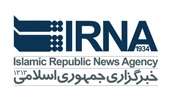Islamic Republic News Agency
The Islamic Republic News Agency (Persian: خبرگزاری جمهوری اسلامی), or IRNA, is the official news agency of the Islamic Republic of Iran. It is government-funded and controlled under the Iranian Ministry of Culture and Islamic Guidance. The agency also publishes the newspaper Iran. As of 2020, the Managing Director of IRNA is Mohammad Reza Noroozpour. IRNA has 60 offices in Iran and 30 more in various countries around the world.[1]
 | |
| Type | Broadcast newspaper online and mobile |
|---|---|
| Country | Iran |
| Availability | Nationwide |
| Slogan | "A news agency for all Iranian" |
| Owner | Iranian government |
Key people | Mohammad Reza Noroozpour |
Launch date | 13 November 1934 (PARS newspaper) |
Former names | Pars news agency (1934–1981) |
Official website | www.irna.ir |
History
In 1934, Pars Agency was established by the Foreign Ministry of Iran (Persia) as the country's official national news outlet.[2] For the next six years it operated under the Iranian Foreign Ministry working to disseminate national and international news. Pars Agency published a bulletin twice daily in French and Persian, which it circulated among government officials, international news agencies in Tehran and the local press. In May 1940, the General Tablighat Department was founded and the agency then became an affiliate of the department. Agence France Press (AFP) was the first international news agency whose reports Pars Agency used. Gradually, the Iranian news agency expanded its sources of news stories to include those of Reuters, the Associated Press (AP) and the United Press International (UPI). An agreement with the Anatolia News Agency of Turkey further expanded the agency's news outlets to countries worldwide. The link-up also enabled it to provide classified bulletins to a limited number of high-ranking public officials.
In 1954, following a coup the reforms of the White Revolution helped to modernize the Pars Agency, leading to expanded news coverage, improved professional services and a better-educated staff. It went on air with radio broadcasts of international news translated into Persian, which it offered to local subscribers. Under the new regime, it operated under the supervision of various state offices and ministries such as the Ministry of Culture, Ministry of Post, Telegraph and Telephones, Office of the Prime Minister and the Labor Ministry until 1947. In 1957, the General Department of Tablighat fell under the supervision of the Publications Department of Tehran Radio as an independent department. In 1963 the activities of Pars Agency were brought under the newly created Information Ministry. Its name was changed to Pars News Agency, or PANA, and it began operating around the clock. In July 1975 the Iranian legislature passed a bill establishing the Ministry of Information and Tourism and changing the status of Pars News Agency to a joint public stock with capital assets of about 300 million rials. It then became an affiliate of the new ministry. Its Articles of Association in 23 paragraphs and notes were adopted by the then National Consultative Assembly of Iran.
After the Iranian Revolution in February 1979, the Revolutionary Council (Shawra-ye-Enqelab), in June 1979, renamed the Ministry of Information and Tourism to the National Guidance Ministry (or Ministry of National Guidance). The same year Pars News Agency was renamed as the Islamic Republic News Agency.[2]
References
- "Ahmadinejad takes over Iranian official news agency". Payvand.com. Retrieved 2011-11-25.
- "Guide to Iranian Media and Broadcast" (PDF). BBC Monitoring. March 2007. Retrieved 12 September 2014.